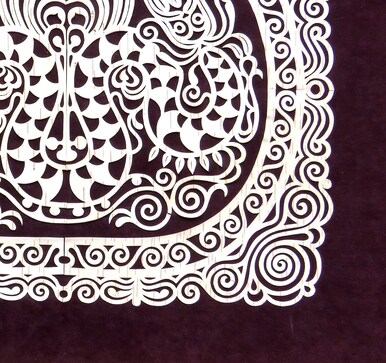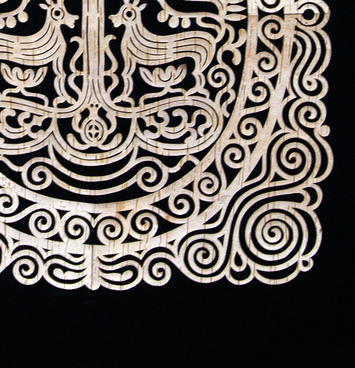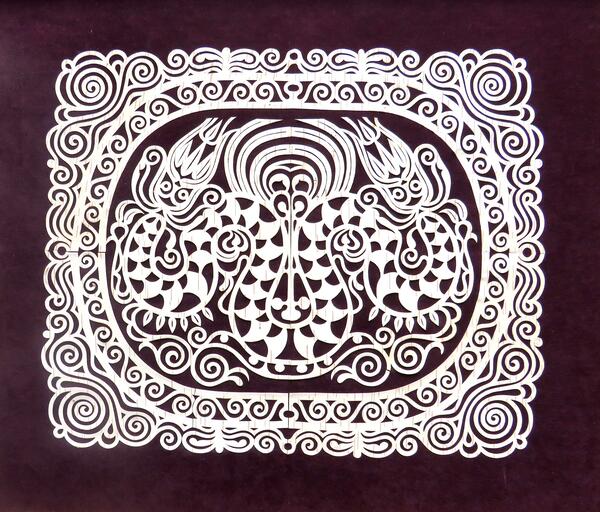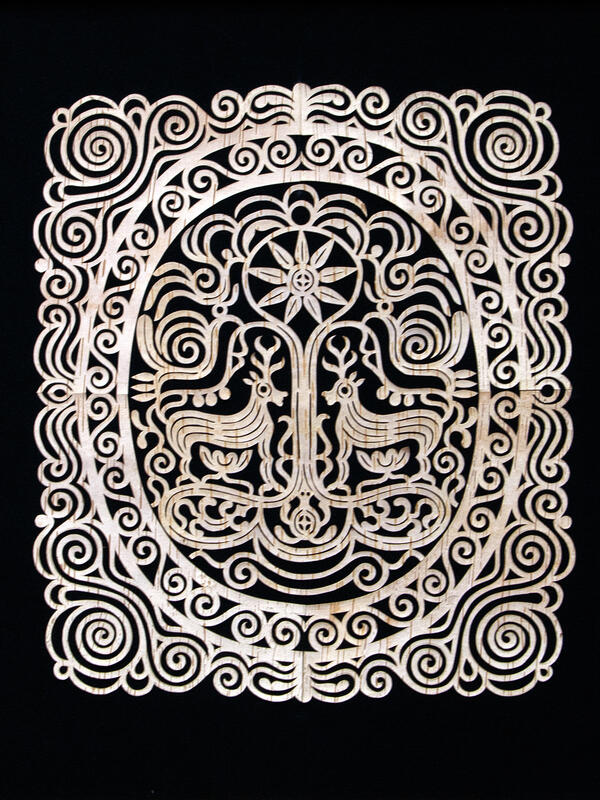A Nanai craftswoman Lyudmila Ulamovna Passar (1950–2012) was born in the village of Naykhin. She loved to watch needlewomen at work and listen to ancient legends. The girl’s grandmother Boly taught her the Nanai language, and at the age of seven, inspired by the lightness of tulle curtains, young Lyudmila began cutting patterns from paper (her grandmother used to praise her by saying, “She cuts well and does not spoil the pattern.”) The young craftswoman’s father took the collection of the works to the Troitskoye village for a children’s art show. However, the works were rejected, as there were doubts that they had been made by a child.
After graduating from school, Lyudmila Passar enrolled in the Nikolayevsk-on-Amur Teacher-Training College and then, without informing her family, she went to Leningrad to study graphic art at the Herzen University. Her involvement in Leningrad cultural scene perfectly intertwined with the artist’s interest in the ethnic roots and legends of her people.
Lyudmila Passar’s favorite technique was birchbark carving. The openwork quality of her works, inspired by the style of the 18th — early 20th centuries, closely resembles the traditional art of the Nanai people.
The seamstress devoted over thirty years of her life to developing the theme of the legends about the Passar, Beldy, Hodzher, Samar and other families. In all families, the first people are believed to have been born from a miraculous meeting of a foremother (or a forefather) with a totemic animal: a tiger, a deer, a bear, or an eagle.
The legend of the Samar family says that once upon a time all the villagers died of an epidemic and only one girl was spared. One day, droppings of an eagle flying high in the sky landed on her shoulder. Soon, the young woman fell pregnant and gave birth to a son. The boy grew up, paid a bride price to get married, and he and his wife had three sons who became “brave men” and the first people of the Samar family — the Samagirs.
In the 17th century, the first Samagirs, who roamed across the taiga, moved to the area of the Gorin River. Between their lands and those belonging to the Golds — local Nanai tribes — there was “an empty strip of 120–130 miles, where Samagir and Gold hunters temporarily resided in winter huts.” By the early 20th century, this border between nomadic tribes and sedentary fishermen was gone.
The peoples of the Amur region have long worshiped the Gusiye Eagle as an incarnation of the demiurge god Boa Endurni. According to legend, when there was neither land nor water, he was flying “over the caves” when he saw Na Endurni — the lower god of the Earth disguised as an elderly woman. Asking her for some earth, he scattered it over the mud, creating dry lands, hills and mountains, which were then surrounded by water.
Lyudmila Passar’s works have participated in many regional, krai, all-Union and national exhibitions and can be found in the museums of Saint Petersburg, Moscow, Zagorsk, Khabarovsk, Komsomolsk-on-Amur and even Japan.
After graduating from school, Lyudmila Passar enrolled in the Nikolayevsk-on-Amur Teacher-Training College and then, without informing her family, she went to Leningrad to study graphic art at the Herzen University. Her involvement in Leningrad cultural scene perfectly intertwined with the artist’s interest in the ethnic roots and legends of her people.
Lyudmila Passar’s favorite technique was birchbark carving. The openwork quality of her works, inspired by the style of the 18th — early 20th centuries, closely resembles the traditional art of the Nanai people.
The seamstress devoted over thirty years of her life to developing the theme of the legends about the Passar, Beldy, Hodzher, Samar and other families. In all families, the first people are believed to have been born from a miraculous meeting of a foremother (or a forefather) with a totemic animal: a tiger, a deer, a bear, or an eagle.
The legend of the Samar family says that once upon a time all the villagers died of an epidemic and only one girl was spared. One day, droppings of an eagle flying high in the sky landed on her shoulder. Soon, the young woman fell pregnant and gave birth to a son. The boy grew up, paid a bride price to get married, and he and his wife had three sons who became “brave men” and the first people of the Samar family — the Samagirs.
In the 17th century, the first Samagirs, who roamed across the taiga, moved to the area of the Gorin River. Between their lands and those belonging to the Golds — local Nanai tribes — there was “an empty strip of 120–130 miles, where Samagir and Gold hunters temporarily resided in winter huts.” By the early 20th century, this border between nomadic tribes and sedentary fishermen was gone.
The peoples of the Amur region have long worshiped the Gusiye Eagle as an incarnation of the demiurge god Boa Endurni. According to legend, when there was neither land nor water, he was flying “over the caves” when he saw Na Endurni — the lower god of the Earth disguised as an elderly woman. Asking her for some earth, he scattered it over the mud, creating dry lands, hills and mountains, which were then surrounded by water.
Lyudmila Passar’s works have participated in many regional, krai, all-Union and national exhibitions and can be found in the museums of Saint Petersburg, Moscow, Zagorsk, Khabarovsk, Komsomolsk-on-Amur and even Japan.




